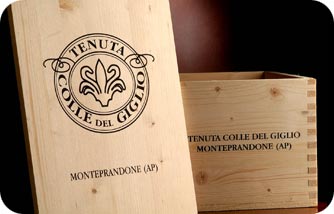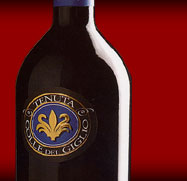 |

|
|
|
The vine: implantation and grape-harvesting
The 82 hectares of Tenuta Colle del Giglio are partly wooded and partly vineyards of different types of vines planted in successive periods.
Some of the vineyards have been there for decades as Montepulciano vine, Cabernet Sauvignon, Chardonnay and Sauvignon Blanc. Starting from 2002 these vines have been re-implanted adopting a more updated planning, that is high denseness of stumps per hectare, reducing the production quantity in favour of better quality.
There are also other types of international vines, such as Syrah, Cabernet Franc and Merlot.
Thanks to thorough pruning and thinning out, the production reaches about 3.5 tons per hectare, a quantity three or four times inferior to the regional average.
Thinning is made when the grapes change color. This enables us to anticipate maturation and concentrate the grapes substances in a limited number of bunches, with the obvious result of a better quality of the fruit.
Harvesting is carefully planned so that the perfect bunch can be picked at the right moment.
The grapes are harvested by hand and put into crates between the second and third decades of August for white wines (Chardonnay and Souvignon Blanc). For red wines the grapes are harvested from the first decade (early varieties such as Merlot and Syrah) to the last decade of October (late varieties such as Montepulciano and Cabernet Sauvignon).
Once harvested the bunches are further selected before the winemaking process.
|
|
|
In the winery: processing and fining
UMuch care is given to the processing of the grapes in the winery. As we already mentioned, the grapes are carefully selected on arrival and before the vinification process. The same care is dedicated to fining. Only new barriques are used and the long contact of the wine with the lees allows the extraction of aromas that give the wine its character; the fining of the bottled wines takes place in the winery in air-conditioned rooms and the wine is marketed only when it is perfectly mature.
The vinification process of white wines is different from that of the red ones.
Here is a short description of the main phases of both production processes.
|
|
|
Production process for white wines vinification
As in the case of red grapes, white grapes too are carefully selected before they are sent to the winery for vinification.
The previously cooled down grapes are conveyed directly to the press and pressing is the first phase of the vinification process when the liquid fraction is separated from the solid ones. Only about 30% of the must is used and put in stainless steel tanks and then conveyed to the next processing phases.
Once the natural decantation is over, the alcoholic fermentation starts at a controlled temperature lower than 20°C, exactly 16/18°C. At this point the fermentation of Chardonnay continues in barriques, and the fermentation of Sauvignon continues in stainless steel containers.
Once the natural fermentation is completed, the product is kept in contact with the lees for a period varying according to the characteristics of the wine. The length of the period depends on the time the components of the micro-organisms' lysed cells need for their transmission.
Fining is the last phase. As already mentioned, depending on the type of wine fining starts either in barriques or in stainless steel containers, but it always ends in a bottle. The fining period varies from 6 months for Sauvignon, up to one year for Chardonnay.
|
|
|
Production process for red wines vinification
When the grapes arrive at the winery, the picking of the grapes from the bunch takes place. In this phase the grape stalks are separated from the grapes and the grapes are lightly pressed. The product obtained is pumped into the 'fermentino'. The two next phases start: fermentation and maceration.
The must undergoes alcoholic fermentation and, through the maceration process of the skins the RIMONTAGGI and the wine pressing take place to aid the dissolution of the substances contained in the skins. The frequency of these operations varies according to the characteristics of the grapes and the results desired. The temperature of maceration is 24-26°C and the process lasts from 40 to 50 days.
Once fermentation and the required period of maceration are over, the racking off starts to separate the liquid fraction from the solid parts. When the marcs have been separated from the liquid part, they are conveyed to the press. The wine that appears cloudy after the racking off process is stocked in stainless steel containers for one or two days to allow the separation from the gross lees.
Casking is the next phase. The wine with its fine lees is put in 225 and 160 litre barriques where it will rest from 12 to 18 months depending on the type of wine. The lees, which deposit at the bottom of the barriques, are stirred weekly using the batonnage technique.
The temperature of the cellar is kept constant at about 20°C to help malolactic fermentation.
Besides the ageing in barriques, the wine is further fined in the bottle for 12 months. Now the wine is ready to be enjoyed.
|
|
|
Batonnage
Tenuta Colle del Giglio use the "batonnage" technique for some of their products.
Batonnage originates from France and consists in the mixing of the wine inside the small barrels (barrique) by means of a mixing stick ( baton in French) that moves the lees, i.e. the sediments which settle at the bottom, causing them to come to the surface in suspension. "Batonnage" is done for a few minutes weekly for at least six months. The 'baton' is a steel bar with some chains attached to its end, so that all the parts of the barrique can be reached by rotating it.
The use of this technique improves the quality of the wine as, besides giving it a better structure, it increases its elegance, the aroma complexity and flavor. The wines treated with this technique tend to be more delicate, less astringent, with less aggressive tannins while, at the same time, mellow and wrapping. Batonnage gives the wine more body and improves its longevity.
|
 |
|
Packaging
If quality research, cultivation methods, skill and professional competence are of the utmost importance, Tenuta Colle del Giglio also does its very best in packaging.
Elegant wooden boxes have been chosen to package the elegant bottles. Quality research is a full range research. Nothing is left to chance, packaging included!
|
|
 |



